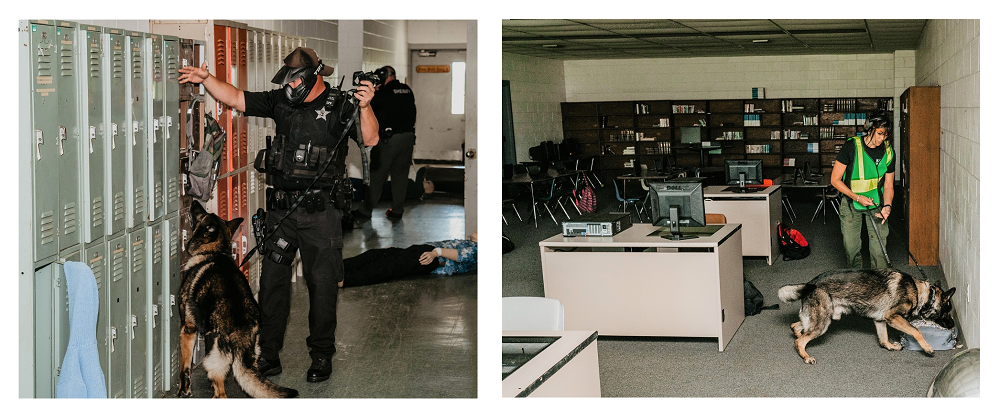
Canines are widely used by law enforcement agencies and first responders to protect the homeland in various ways. Specially-trained dog teams, for instance, are deployed to disaster scenes and in urban search and rescue missions because of their keen sense of smell, speed, and ability to maneuver in tight spots. Explosive detection canine teams, too, are no stranger to dangerous working conditions. They are used throughout critical infrastructure to detect explosive devices.
More and more often, canines are the unsung heroes in times of emergency, and first responders are increasingly relying on them as the first line of defense during tactical missions, with the hope that these highly trained dogs and their handlers can help them implement a safer and more effective response. And now, the Department of Homeland Security (DHS) Science and Technology Directorate (S&T) is studying how they might be used in new, non-traditional ways, like in active shooter scenarios, to detect potential explosive threats – clearing the way for responders to quickly engage hostile adversaries or administer aid to those who need it.
Until recently, no testing, evaluation, or assessment had ever been done to determine how canine teams would respond to an active shooter scenario. In September 2019, S&T’s Detection Canine Program, in partnership with Battelle Memorial Institute and the Counterterrorism Advanced Training Center (CTATC), designed, sponsored and implemented two innovative pilot study demonstrations to explore the proof of concept role of canine teams in an active shooter response situation.
“Explosive detection canines are one of the best, most versatile mobile detection tools available for protecting the homeland from explosive threats,” said Don Roberts, S&T Detection Canine Program Manager. “However, the concept of them partnering with first responders in active shooter response scenarios is a new and innovative idea.”
Prior to conducting the pilot study demonstrations, canine subject matter expert (SME) participants from S&T’s Detection Canine Program held a roundtable exercise with law enforcement and fire and EMS personnel to discuss their respective roles in active shooter scenarios and brainstorm if explosive detection canine teams might need any special training in order to effectively work with them during these incidents. Together, they decided that the pilot study demonstrations should help them determine:
- Whether or not canine teams would be able to respond to and work well in these types of chaotic, high stress environments;
- Whether or not canine teams would be able to successfully clear a high-risk area;
- What benefit and/or liability the canine teams might be during these scenarios; and
- What kind(s) of training and testing canine teams would need to undergo to excel in these scenarios.
With these questions in mind, SMEs from S&T’s Detection Canine Program gathered with local first responders and explosive detection canine teams at CTATC to test the efficacy of the canine teams in realistic scenarios. Both the responders and canine teams participated in active shooter scenarios that included realistic weapons fire from various “shooters,” exposure to spent ammunition casings and smoke, hidden pipe bombs and other explosive targets, and encounters with both hostile assailants and victims in need of immediate first aid.
The mock scenarios included staged attacks in a classroom setting and in a house of worship. As the responders and explosive detection canine teams went through the various scenarios, S&T collected qualitative and quantitative data to measure the performance of the canine teams to discover how they could integrate with the responders during an active shooting event. After the pilot study demonstrations were over, S&T’s experts met with both the first responders and canine teams to get their input and feedback on how proficient they felt during the simulations.
The SMEs found that experience played a big role in how effective the participating explosive detection canine teams were at responding during active shooter scenarios. Canine teams frequently train in their actual working environment, so these scenarios represented a new kind of setting for the teams. The more experienced the team, the more comfortable they were with adapting to the different kinds of stimulus encountered in this new environment and helping to clear a scene quickly and efficiently for responder safety. However, the SMEs also noted that their data was preliminary and that further studies would be required.
“Based on our first two active shooter response pilot demonstrations, it’s fair to say that explosive detection canine teams can potentially be a great asset to first responders during an active shooting scenario,” said Roberts. “However, we will need to conduct more studies and collect more data on the canine teams specifically, before we can draw any statistically significant conclusions. In the meantime, these initial pilot demonstrations have provided us with enough data to provide recommendations and advice to responders who are considering integrating canine teams into their active shooter responses.”
The recent active shooter response pilot demonstrations are only one part of the Detection Canine Program’s ongoing efforts to provide first responders with better tools, techniques and knowledge that will empower them to do their jobs more safely and effectively. The Detection Canine Program also hosts the Regional Explosives Detection Dog Initiative (REDDI) — a two-day outreach event for state and local law enforcement that includes odor recognition trials and reality-based operational search scenarios for canine teams. S&T also partners with law enforcement canine teams in the national capitol area to conduct operational tests and evaluations designed to help improve the effectiveness and efficiency of explosive detection canine teams.

